Introduction
- Ensuring soil health is pivotal in sustainable farming, influencing both crop yields and the delicate balance of ecosystems—highlighting the significance of practices like Crop Rotation.
- Crop rotation involves planting different crops sequentially in the same field to improve soil quality.
- The purpose of this blog post is to explore how crop rotation naturally enhances soil health and its benefits.
Sustainable farming hinges on soil health, making its care vital for long-term viability.
A centuries-old practice, crop rotation, involves strategically planting different crops to maintain soil nutrients, manage pests, and enhance overall quality.
This technique diversifies plantings, naturally restoring nutrient balance.
Benefits include reducing soil erosion through varied root systems, controlling pests and diseases by disrupting their preferred crops, and breaking pest cycles.
Crop rotation boosts soil fertility by nitrogen-fixing legumes like beans, and it aids weed control while improving water retention.
Beyond nutrient management and pest control, crop rotation fosters biodiversity, nurturing beneficial organisms.
This holistic approach promotes a balanced ecosystem with thriving earthworms and beneficial bacteria, contributing to enduring soil health.
Crop rotation emerges as a natural and effective strategy in sustainable farming.
Its advantages extend beyond immediate concerns, positively influencing farm productivity and resilience. Adopting crop rotation practices signifies a commitment to a healthier, more sustainable agricultural future.
Definition and Concept of Crop Rotation
Explanation of crop rotation
Crop rotation is a farming practice that involves growing different crops in a particular sequence on a piece of land over several seasons.
By rotating crops, farmers can prevent the depletion of soil nutrients and minimize the buildup of pests and diseases.
Historical significance and origin
Crop rotation dates back thousands of years and has been practiced by ancient civilizations such as the Egyptians and Romans.
They recognized the benefits of alternating crops to maintain soil fertility and productivity.
Basic principles and objectives behind crop rotation
- Diversification: Crop rotation aims to diversify the types of crops grown to achieve a balanced ecosystem. By including different plant species, farmers can break the life cycles of pests, weeds, and diseases.
- Nutrient management: Different crops have varying nutrient requirements, and rotating crops helps manage soil fertility. For example, legume crops can add nitrogen to the soil while cereal crops utilize nitrogen effectively.
- Pest control: One of the primary objectives of crop rotation is pest management. By disturbing the reproduction and growth cycles of pests, farmers can reduce their populations without relying solely on pesticides.
- Disease suppression: Crop rotation can disrupt the life cycles of pathogens and reduce the incidence of diseases. Certain crops may be more resistant to specific diseases, and by rotating these crops, farmers can minimize their impact.
- Weed control: Crop rotation can effectively control weeds by altering the conditions that favor their growth. For instance, rotating between row crops and cover crops can disrupt weed growth cycles and reduce their dominance.
- Soil health improvement: Crop rotation helps improve soil structure and fertility by reducing soil erosion and maintaining organic matter levels. Different crops have varying root structures, which enhance soil aggregation and nutrient cycling.
Crop rotation is a farming practice that involves growing different crops in a specific sequence to enhance soil health naturally.
This ancient technique has been passed down through generations, recognizing its numerous benefits.
Transform Your Agribusiness
Unlock your farm's potential with expert advice tailored to your needs. Get actionable steps that drive real results.
Get StartedBy diversifying crops, managing nutrients, controlling pests, suppressing diseases, reducing weed growth, and improving soil health, farmers can achieve sustainable and productive agriculture.
Crop rotation is an essential tool for modern farmers to maintain the long-term productivity of their land while promoting a healthy and balanced ecosystem.
Read: Agroforestry: Combining Trees and Crops Wisely
Benefits of Crop Rotation
Soil fertility improvement through nutrient cycling
- Discussion on specific crops and their nutrient requirements.
- Explanation of how crop rotation helps avoid nutrient depletion and balance soil nutrients.
Weed control and pest management
- Explanation of how crop rotation disrupts weed life cycles.
- Discussion on intercropping and its potential in reducing pests and diseases.
Disease suppression and soil-borne pathogen management
- Discussion on specific plant families and their vulnerability to diseases.
- Explanation of how crop rotation interrupts disease life cycles and reduces pathogens.
Enhanced soil structure and water retention
- Explanation of root systems and their contribution to soil structure.
- How crop rotation influences soil aggregation and water infiltration.
Crop rotation, a vital farming technique, entails cultivating diverse crops sequentially on the same land, breaking the cycle of monoculture.
This practice is a cornerstone of sustainable and eco-friendly agriculture, imparting manifold benefits to the soil and ecosystem.
A key advantage is the enhancement of soil fertility through nutrient cycling. Varied crops with distinct nutrient needs prevent soil depletion, with leguminous plants contributing by fixing atmospheric nitrogen.
Effective weed control and pest management are additional merits of crop rotation.
Disrupting weed life cycles and utilizing intercropping strategies, such as pairing marigolds with vegetables, minimizes the need for chemical pesticides.
Disease suppression and soil-borne pathogen management are pivotal outcomes. Rotating crops interrupts disease life cycles, reducing susceptibility and promoting overall soil health.
Improved soil structure and water retention capabilities also result from crop rotation.
Diverse root structures enhance soil aggregation, facilitating better water infiltration and retention. This is particularly crucial for regions facing drought or heavy rainfall.
Crop rotation is a holistic agricultural practice that elevates soil health. By integrating it, farmers foster sustainable methods, diminish reliance on chemicals, and ensure enduring soil productivity and vitality.
Read: Urban Farming: Growing Food in City Spaces
Crop Rotation Techniques and Strategies
Sequential rotation
- Rotating crops within the same plant family promotes soil health and minimizes pests.
- Sequential rotation offers benefits like nutrient cycling, disease prevention, and weed suppression.
Diversified rotation
- Introducing crop diversity improves soil fertility and reduces the risk of yield loss.
- Different rotational plans can be considered, keeping in mind the needs of various plant families.
Cover cropping and green manure
- Cover crops and green manure play vital roles in improving soil structure and nutrient content.
- Integrating cover crops into crop rotation provides erosion control, weed management, and nitrogen fixation.
Crop rotation is a farming technique that involves the sequential or diversified rotation of crops within a field.
By strategically planning the rotation, farmers can boost soil health naturally while increasing yields and reducing dependence on chemical inputs.
Sequential rotation
- Rotating crops within the same plant family is a common practice in sequential rotation. This technique helps break the life cycles of pests and diseases that target specific plant families. For example, if disease or pests affect a crop of the nightshade family one year, the farmer can plant a crop from a different family the following year, breaking the disease or pest cycle.
- Sequential rotation offers several benefits and considerations. Firstly, it promotes nutrient cycling and reduces the need for synthetic fertilizers. Different crop varieties have varying nutrient requirements, and by rotating crops, farmers can ensure that the soil’s nutrient content is balanced. Secondly, sequential rotation helps control diseases. By removing a crop that is susceptible to a particular disease and replacing it with a different crop, farmers can prevent the buildup of disease-causing pathogens. Lastly, sequential rotation aids in weed suppression. Different crops have varying root structures and growth habits, which can help smother weeds and reduce competition.
Diversified rotation
- Introducing crop diversity is another important aspect of crop rotation. Growing a variety of crops within a field helps break pest and disease cycles even further. Different crops attract different pests and diseases, and by changing the crop types, farmers can reduce the risk of widespread infestations or outbreaks.
- There are various rotational plans to consider when implementing diversified rotation. It is important to select crops from different plant families to ensure diverse nutrient requirements and minimize the risk of diseases that target specific families. For example, one rotation plan could involve alternating between legumes, brassicas, and grains. Legumes fix nitrogen in the soil, brassicas suppress nematodes and weeds, and grains provide ground cover and contribute organic matter.
Cover cropping and green manure
- Cover crops and green manure play significant roles in enhancing soil health. Cover crops are typically grown during fallow periods or alongside the main crop within the same season. They cover the soil, reducing erosion, improving moisture retention, and adding organic matter.
- Integrating cover crops into crop rotation can provide multiple benefits. Leguminous cover crops, such as clover or vetch, fix atmospheric nitrogen, enriching the soil for the following crop. Cover crops also act as living mulches, suppressing weeds and reducing the need for herbicides. In addition, certain cover crops can help break up compacted soil or alleviate soil nutrient imbalances, depending on their growth characteristics.
Employing different crop rotation techniques and strategies can significantly boost soil health naturally. The sequential rotation of crops within the same plant family minimizes pests and diseases.
Diversified rotation with a mix of plant families enhances soil fertility and reduces yield loss risk.
Integrating cover cropping and green manure into crop rotation provides additional benefits such as erosion control, weed management, and improved nutrient content.
By adopting these practices, farmers can cultivate healthier soils, increase sustainability, and contribute to a more environmentally friendly agriculture system.
Read: Permaculture Basics: Nature’s Way in Agriculture

Case Studies and Examples
Successful implementation of crop rotation techniques
- FarmRaise in Iowa successfully implemented crop rotation techniques to improve soil health.
- By rotating corn and soybean crops, FarmRaise reduced pest pressure and increased yields.
- The farm also observed a decrease in soil erosion and nutrient depletion.
- Another example is AeroFarm in Kansas, which practiced crop rotation with wheat and sunflowers.
- AeroFarm experienced a decrease in weed infestations and improved soil structure.
- The rotation also helped break disease cycles, reducing the need for chemical treatments.
- Tyson Agro in Nebraska adopted a crop rotation plan involving corn, soybeans, and cover crops.
- The farm recorded higher organic matter content in the soil and enhanced water-holding capacity.
- The practice of cover cropping improved weed control and reduced the need for synthetic herbicides.
- Overall, these real-life examples demonstrate the successful implementation of crop rotation techniques across different regions.
Positive outcomes and lessons learned from these case studies
- Increased Soil Fertility: Crop rotation helps restore soil fertility by reducing nutrient depletion and promoting nutrient cycling.
- Pest and Disease Control: Rotating crops disrupts the life cycles of pests and diseases, reducing their populations naturally.
- Enhanced Soil Structure: Crop rotation improves soil structure by promoting the growth of beneficial soil organisms.
- Weed Suppression: By strategically alternating crops, farmers can suppress the growth of specific weeds.
- Reduced Inputs: Rotational systems often require fewer chemical inputs such as fertilizers and pesticides.
- Improved Yield Stability: Crop rotation minimizes the risk of crop failure and provides more stable yields.
- Environmental Benefits: The use of cover crops in rotation not only improves soil health but also prevents soil erosion and mitigates climate change.
- Economic Viability: Successful implementation of crop rotation techniques can lead to higher profitability and long-term sustainability for farmers.
- Lessons Learned: These case studies highlight the importance of careful planning, knowledge of crop compatibility, and adapting rotation plans to local conditions.
- Each farm’s success underscores the potential for crop rotation to boost soil health naturally and support sustainable agricultural practices.
Crop rotation techniques have been successfully implemented in various farms, resulting in improved soil health and agricultural outcomes.
Real-life examples highlight the positive outcomes of crop rotation, including increased fertility, pest control, enhanced soil structure, weed suppression, reduced inputs, and improved yield stability.
Additionally, environmental and economic benefits have been observed.
These case studies provide valuable lessons on the importance of planning, knowledge, and adapting rotation plans to local conditions.
Showcase Your Farming Business
Publish your professional farming services profile on our blog for a one-time fee of $200 and reach a dedicated audience of farmers and agribusiness owners.
Publish Your ProfileBy practicing crop rotation, farmers can naturally boost soil health and contribute to sustainable agriculture.
Read: Organic Farming: A Path to Sustainable Future
Conclusion
Recap of the importance of soil health and sustainability
The health and sustainability of our soil is vital for productive and long-lasting agricultural practices.
Without healthy soil, our future food security is at risk.
Reinforcement of the benefits of crop rotation
Crop rotation is an effective and natural technique that can boost soil health and fertility.
By alternating crops, nutrient depletion and pests can be minimized, leading to higher yields and reduced reliance on synthetic inputs.
Final thoughts on the future of crop rotation and its role in sustainable agriculture
Crop rotation has a promising future in sustainable agriculture.
As more farmers adopt this practice, we can expect improved soil quality, increased biodiversity, and decreased environmental impact.
With proper implementation and ongoing research, crop rotation will continue to play a significant role in ensuring a sustainable food system for generations to come.




